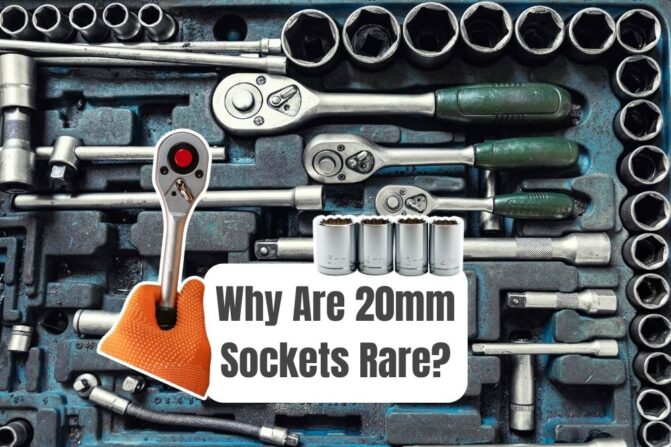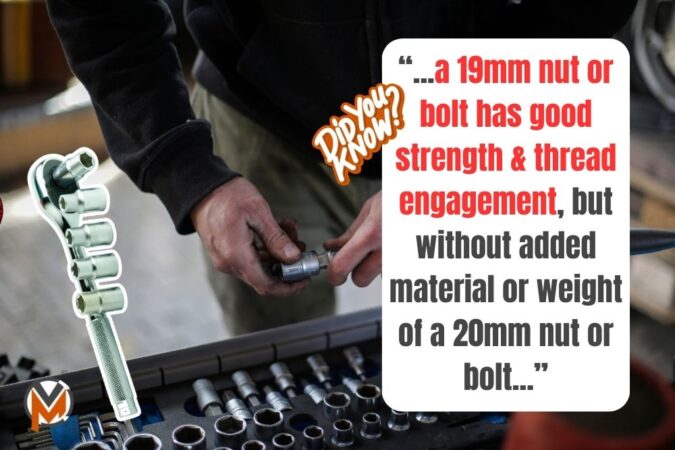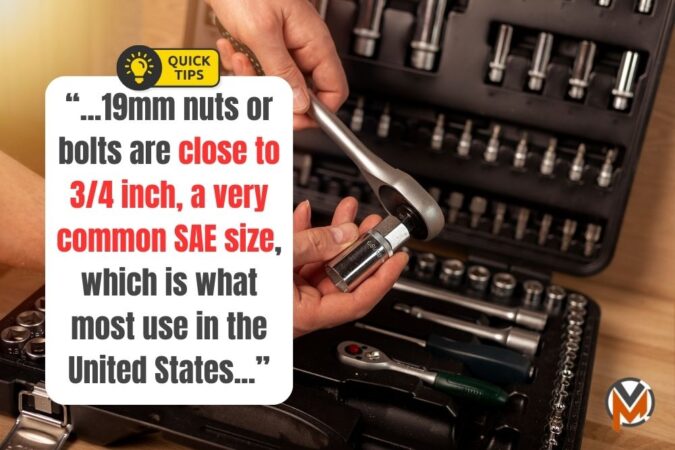Socket sizes are as varied and as diverse as the automotive landscape, as a whole. Yet, among all the many socket sizes that we commonly use on our vehicles, from 5 mm to 36 mm, why are 20 mm sockets so rare?
I’m not the only person noticing this either, as countless other people have noticed it, too. Whereas sockets like 8 mm, 10 mm, 12 mm, and so on are fairly common for cars, 20 mm ones are practically non-existent.
Besides wild conspiracy theories, there are good reasons why most cars use nuts and bolts that skip 20 mm, and simply use 19 mm and 21 mm ones. Quite simply, 20 mm nuts and bolts don’t offer many practical benefits.
19 mm nuts and bolts are strong enough that 20 mm ones aren’t worth the added material and weight. On the other hand, 21 mm offers far better strength than 20 mm, which essentially renders 20 mm redundant.
Here are a few other reasons why 20 mm nuts and bolts (and subsequently, the sockets that go with them) are rare when it comes to working on cars…
- Evolution of the metric system
- Mechanical efficiency & load bearing
- Space constraints & manufacturing
- Standardization & availability of tools
- Influence from tool manufacturers
Reason #1: Historical Precedent With The Metric System
In the realm of automotive engineering and cars in general, the metric system’s influence is quite profound. Particularly, when it comes to the selection of nut and bolt sizes, as well as the sockets to work on them.
The preference for certain sizes like 19 mm and 21 mm – over 20 mm nuts and bolts – is rooted thanks to a combination of historical precedent, adapting existing solutions, mechanical efficiency, and practicality.
Over many decades, certain metric sizes (such as 19 mm and 21 mm) have become much more prevalent in automotive design due to their widespread adoption in early vehicles. There’s a good reason for this, too.
These nut and bolt sizes have continued to be used in most cars thanks to the legacy of the designs and the widespread availability of tools (such as sockets) for these sizes. Basically, if it ain’t broke, don’t fix it.
Reason #2: Mechanical Efficiency & Load Bearing Requirements
Another reason why 20 mm nuts and bolts are so rare lies in its very design. Oftentimes, 19 mm and 21 mm nuts and bolts are often chosen for their mechanical efficiency. Specifically, in regards to their strength.
For example, a 19 mm nut or bolt commonly provides adequate strength, and thread engagement for most automotive applications, without the additional material and weight that a 20 mm bolt would entail.
This efficiency in material usage is crucial in cars, where every extra gram would impact fuel efficiency and performance. Moreover, in automotive design, the load-bearing capacity of a nut or bolt is important.
The respective 19 mm and 21 mm nut and/or bolt sizes are often sufficient to handle the loads experienced in most automotive applications. In other words, just how strong they are to hold something together.
Engineers might otherwise find that a 19 mm nut or bolt could handle the required load efficiently, making the slightly larger 20 mm bolt unnecessary. Similarly, if you’re handling heavier loads, just skip to 21 mm.
Reason #3: Space Constraints, Manufacturing, & Supply Chains
In the compact working environment of a car, space always comes at a premium. Designers often prefer to use the smallest bolt that could do the job effectively to save space. This is something I know all too well.
The more time you spend underneath the hood of a car, the more you realize just how cramped everything is in there. Therefore, smaller nuts and bolts help to save space, even just a tiny bit, to make things easier.
On the subject of saving space, there’s also the material cost of 20 mm over 19 mm. This is another reason why the smaller 19 mm bolt is often chosen over the bigger 20 mm, as the latter uses more raw materials.
Additionally, using more common sizes like 19 mm and 21 mm helps streamline the manufacturing process and simplifies the supply chain. In short, the rarity of 20 mm makes it that less appealing to manufacture.
Furthermore, 19 mm and 21 mm nuts and bolts are far easier and more cost-effective for manufacturers to source and stock a limited range of sizes, that are used across multiple vehicle models and spare parts.
Reason #4: Uniformity, Standardization, & Tool Availability
The 19 mm size for nuts and bolts, in particular, is rather close in size to the 3/4 inch, a common size in the SAE (Society of Automotive Engineers) standard. The latter is what most folks use in the United States.
This compatibility allows for greater flexibility in tool usage across different standards. The 21 mm size, on the other hand, is used for larger bolts where more strength is needed. But, without needing to jump to 22 mm.
There’s a significant advantage in using sizes – nuts, bolts, sockets, etc. – that are already widely adopted in the industry. This can lead to uniformity in the manufacturing process or while you’re performing repairs.
By sticking to these common nuts, bolts, and socket sizes, manufacturers can ensure that their vehicles are easier to service and repair. This is a key consideration for both manufacturers and consumers alike.
Reason #5: Size Overlaps & The Influence Of Tool Manufacturers
With the metric system, which is predominantly used in automotive engineering, certain sizes of nuts, bolts, sockets, and other tools or components are more common due to their practicality and convenience.
This is similar to the point I made earlier in #2. For instance, sizes such as 10 mm, 13 mm, 17 mm, and 19 mm are frequently used because they correspond really well to the needs of most car components & parts.
The 20 mm standard, however, does not significantly differ from 19 mm or 21 mm. Essentially, 19 mm and 21 mm sizes often suffice where a 20 mm might be considered. This makes the latter somewhat redundant.
Equally, tool manufacturers respond to the demands of the market. Since the demand for 20 mm sockets is low, they exclude this size from socket sets. Since fewer people use them, it’s why 20 mm sockets are rare.
This decision is not an arbitrary, mind you. In practice, it’s based on extensive research and understanding of the market’s needs. In stark contrast, you could more easily find and buy 19 mm and 21 mm sockets.



